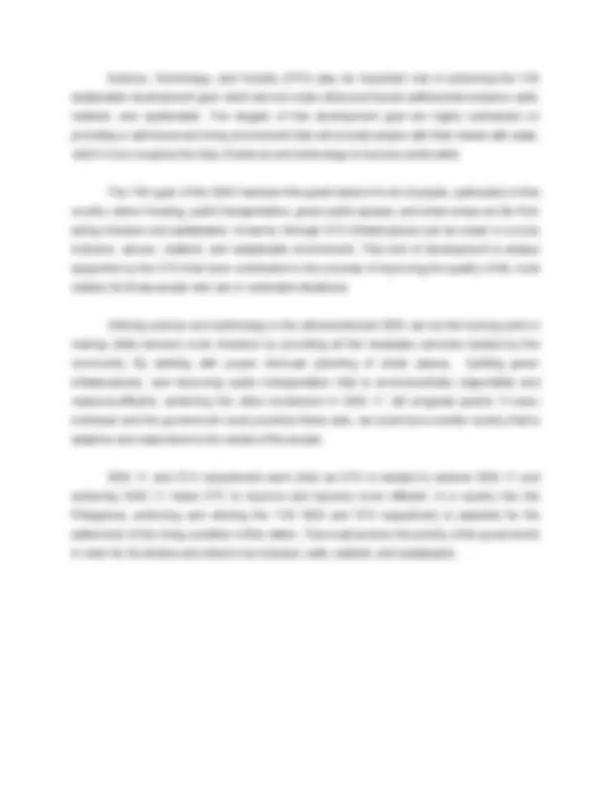





Study with the several resources on Docsity

Earn points by helping other students or get them with a premium plan


Prepare for your exams
Study with the several resources on Docsity

Earn points to download
Earn points by helping other students or get them with a premium plan
Community
Ask the community for help and clear up your study doubts
Discover the best universities in your country according to Docsity users
Free resources
Download our free guides on studying techniques, anxiety management strategies, and thesis advice from Docsity tutors
Example of synthesis paper in Science and Technology course,
Typology: Summaries
Uploaded on 11/23/2023
1 document
1 / 6

This page cannot be seen from the preview
Don't miss anything!




Goal 11 is about making cities and human settlements inclusive, safe, resilient, and sustainable.
As the world struggles with serious environmental and social challenges, the concept of sustainability in urban development gains greater significance. Sustainable cities and communities have emerged as a central pathway toward eradicating extreme poverty and reducing inequality while ensuring universal access to basic resources and services. The increasing urbanization trend demands the creation of livable, resilient, and environmentally friendly urban spaces. It emphasizes the critical role that adopting sustainable practices plays in promoting economic prosperity, social inclusivity, environmental conservation, and overall well-being for both current and future generations. Using information technology in cities to sustain and ensure a high quality of life for its residents encourages the emergence of smartness in human settlements (Miah & Amin, 2020). This leads to continuous growth and development within the cities which will play a part in achieving the 11th Sustainable Development Goal (SDG), making cities inclusive, safe, resilient, and sustainable. The science and technology sector, one of the main industries that has a rapid growth over time, is a significant factor in ensuring that the environment and human interactions are accessible, secure, resilient, and sustainable. For it can result in the development of new knowledge, which can subsequently be used to promote human prosperity and address the various issues society is currently experiencing. Building a framework for swift and adaptable reactions in emergencies is another way that STS contributes to a secure society. Identifying the appearance of fresh opportunities or possible threats in society.
By delivering creative solutions and knowledge, science, and technology help to achieve the SDGs. They encourage data-driven decision-making, renewable energy and climate action,
agricultural productivity, healthcare, and sustainable infrastructure. Their contributions are critical to ensuring a more sustainable future for all. Slum dwellers must be given special attention in cities and communities. As our civilization has grown, facilities have become increasingly important in providing inclusive, safe, and resilient cities and human settlements. We can ensure a higher output of infrastructure and cities that satisfy the needs of the community by using science and technology. Furthermore, this can result in more efficient cities with higher production and innovation, cheaper prices, and lower environmental consequences, as well as improved chances for consumer choices and sustainable lifestyles. The aim of inclusion and sustainability in SDG 11 will be more attainable as a result. Given that more than half of the world's population is expected to live in cities by 2050, it is essential to make cities and human settlements inclusive, safe, resilient, and sustainable (United Nations Statistics Division, n.d.). While the deep inequalities exposed by the COVID- pandemic and other cascading crises highlight the importance of sustainable urban development, strengthening the preparedness and resilience of cities is crucial in responding to upcoming crises. Science and technology significantly impact the world by creating new knowledge and utilizing it to improve the economy, productivity, and future of society. This knowledge is then utilized to enhance human prosperity and address various issues, ultimately contributing to a safer and more productive future. (United Nation statistics, 2011).
The benefit of focusing on sustainable cities and communities is the improvement of urban planning, management, and development to make the world’s urban spaces more inclusive, safe, resilient, and sustainable. One of the important elements towards the development of cities is the businesses for they provide income and boosts productivity, therefore contributing to the overall economic growth. By this, cities generate more than 80% of global gross domestic product (Mowery, B. L. 2021). To further improve the success of SGD 11, businesses should invest and build partnerships in cities upon research, development, and deployment of products and services that will improve access to resilient buildings, green spaces, transport, and utilities. By doing this, businesses and corporations will help ensure that urban projects will not negatively impact the environment and social assets (Basso, G. 2021).
Science, Technology, and Society (STS) play an important role in achieving the 11th sustainable development goal which aims to make cities and human settlements inclusive, safe, resilient, and sustainable. The targets of this development goal are highly centralized on providing a well-improved living environment that will provide people with their needs with ease, which in turn requires the help of science and technology to become achievable. The 11th goal of the SDG has been the great needs of a lot of people, particularly in this country where housing, public transportation, green public spaces, and urban areas are far from being inclusive and sustainable. However, through STS infrastructures can be made in a more inclusive, secure, resilient, and sustainable environment. This kind of development is always supported by the STS that have contributed to the process of improving the quality of life, most notably for those people who are in vulnerable situations. Utilizing science and technology in the aforementioned SDG can be the turning point in making cities become more inclusive by providing all the necessary services needed by the community. By starting with proper land-use planning of urban places, building green infrastructures, and improving public transportation that is environmentally responsible and resource-efficient, achieving the cities envisioned in SDG 11 will progress quickly. If every individual and the government could prioritize these acts, we could have a better country that is adaptive and responsive to the needs of the people. SDG 11 and STS complement each other as STS is needed to achieve SDG 11 and achieving SDG 11 helps STS to improve and become more efficient. In a country like the Philippines, achieving and utilizing the 11th SDG and STS respectively is essential for the betterment of the living condition of the nation. This must become the priority of the government in order for its citizens and cities to be inclusive, safe, resilient, and sustainable.
Arora, V (2021) What Are The Five Features That Make A City ‘Smart’? PlanetCrust, (4) Para. 7 https://www.planetcrust.com/what-are-the-five-features-that-make-a-city-smart?utm_campaign= blog Basso, G. How to achieve sustainable cities and communities. (n.d.). GründerAtelier. https://gruenderatelier.de/how-to-achieve-sustainable-cities-and-communities-sdg11/
Vince, C. & Morrisey, J. (2020) 5 focal points needed to develop a smart city. SmartCitiesDive, Para. 6- https://www.smartcitiesdive.com/news/5-focal-points-needed-to-develop-a-smart-city/580023/